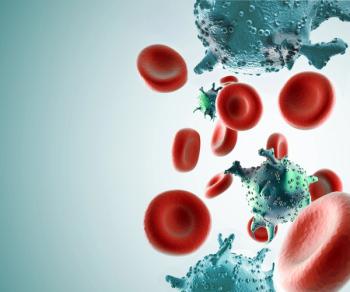
Isatuximab Quadruplet Therapy Shows PFS Advantage in Multiple Myeloma

Isatuximab quadruplet therapy for patients with multiple myeloma prolonged progression-free survival when compared with VRd triplet therapy.
Quadruplet therapy including isatuximab-irfc (Sarclisa) in combination with bortezomib (Velcade), lenalidomide (Revlimid), and dexamethasone (Isa-VRd) was shown to increase progression-free survival (PFS) vs triplet therapy without isatuximab for patients with transplant-ineligible newly diagnosed multiple myeloma (NDMM), according to Thomas G. Martin, MD.
CancerNetwork® spoke with Martin, a clinical professor of Medicine at the Adult Leukemia and Bone Marrow Transplantation Program and associate director of the Myeloma Program at University of California San Francisco (UCSF); and co-leader of the Cancer Immunology & Immunotherapy Program at the Helen Diller Family Comprehensive Cancer Center, about his impression of the
Martin highlighted a PFS benefit with the quadruplet therapy vs VRd triplet therapy, emphasizing that it was the longest PFS he has witnessed that has been published or presented for transplant-ineligible multiple myeloma. He then concluded by expressing his belief that this quadruplet therapy may become the new standard for this indication.
Data presented at the
Based on data from the phase 3 IMROZ trial, the
Transcript:
The phase 3 IMROZ trial did compare the quadruplet of isatuximab, bortezomib, lenalidomide, and dexamethasone, otherwise known as isa-VRd, [with] VRd. Patients were [randomly assigned] to 4 drug induction vs 3 drug [induction] and then received that for 8 to 9 months worth of therapy. Then, [patients] continued on maintenance therapy [including] isatuximab, lenalidomide, and dexamethasone vs what is standard, which is lenalidomide and dexamethasone. It was continuous therapy, and these patients tolerated the therapy quite well.
In fact, there was not a significant safety signal [found with] 4 drugs vs 3 drugs. [The] quadruplet is quite safe, and it is very easy to add isatuximab to what we consider a VRd backbone. The patient population was quite large: over 250 patients received isa-VRd, and 180 patients received VRD. The median age for this group […] was 72 years of age. About 10% of them had high-risk disease, and that is what is typical for this older patient population.
When patients were followed for the events of [PFS], there was a marked advantage in the quadruplet vs the triplet [arm], where the 60-month PFS in the isatuximab arm was 63%, and the 60-month PFS in the VRD arm was 45%; a marked difference. That 63% at 60 months is the longest PFS that we have seen, the longest remission duration of an upfront newly diagnosed multiple myeloma trial in this transplant-ineligible patient population that has ever been published or presented.
This means that patients are going to go more than, on average, 5 years––perhaps it will end up being 6 or 7 years––of remission duration or longer with this combination. That is a huge advantage with this quadruplet vs what we were doing in the past, which was a triplet. It typically was an anti-CD38 [agent] plus lenalidomide as a triplet in the past as our standard. This, in my mind, is the new standard based on this high [PFS] rate.
References
- Facon T, Dimopoulos MA, Leleu XP, et al. Phase 3 study results of isatuximab, bortezomib, lenalidomide, and dexamethasone (Isa-VRd) versus VRd for transplant-ineligible patients with newly diagnosed multiple myeloma (IMROZ). J Clin Oncol. 2024;42(suppl 16):7500. doi:10.1200/JCO.2024.42.16_suppl.7500.
- Facon T, Dimopoulos M-A, Leleu XP, et al. Isatuximab, bortezomib, lenalidomide, and dexamethasone for multiple myeloma. N Engl J Med. Published online June 3, 2024. doi:10.1056/NEJMoa2400712
- FDA approves istauximab-irfc with bortezomib, lenalidomide, and dexamethasone for newly diagnosed multiple myeloma. FDA. News release. September 20, 2024. Accessed September 20, 2024. https://shorturl.at/B8d3c
Newsletter
Stay up to date on recent advances in the multidisciplinary approach to cancer.

















































































